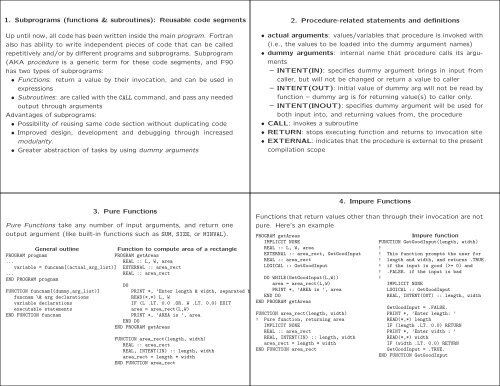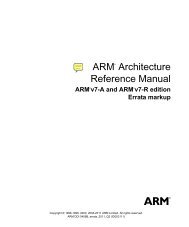1. Subprograms (functions & subroutines): Reusable code segments ...
1. Subprograms (functions & subroutines): Reusable code segments ...
1. Subprograms (functions & subroutines): Reusable code segments ...
Create successful ePaper yourself
Turn your PDF publications into a flip-book with our unique Google optimized e-Paper software.
<strong>1.</strong> <strong>Subprograms</strong> (<strong>functions</strong> & <strong>subroutines</strong>): <strong>Reusable</strong> <strong>code</strong> <strong>segments</strong><br />
Up until now, all <strong>code</strong> has been written inside the main program. Fortran<br />
also has ability to write independent pieces of <strong>code</strong> that can be called<br />
repetitively and/or by different programs and subprograms. Subprogram<br />
(AKA procedure is a generic term for these <strong>code</strong> <strong>segments</strong>, and F90<br />
has two types of subprograms:<br />
• Functions: return a value by their invocation, and can be used in<br />
expressions<br />
• Subroutines: are called with the CALL command, and pass any needed<br />
output through arguments<br />
Advantages of subprograms:<br />
• Possibility of reusing same <strong>code</strong> section without duplicating <strong>code</strong><br />
• Improved design, development and debugging through increased<br />
modularity.<br />
• Greater abstraction of tasks by using dummy arguments<br />
3. Pure Functions<br />
Pure Functions take any number of input arguments, and return one<br />
output argument (like built-in <strong>functions</strong> such as SUM, SIZE, or MINVAL).<br />
General outline<br />
PROGRAM prognam<br />
...<br />
variable = funcnam[(actual_arg_list)]<br />
...<br />
END PROGRAM prognam<br />
FUNCTION funcnam[(dummy_arg_list)]<br />
funcnam \& arg declarations<br />
variable declarations<br />
executable statements<br />
END FUNCTION funcnam<br />
Function to compute area of a rectangle<br />
PROGRAM getAreas<br />
REAL :: L, W, area<br />
EXTERNAL :: area_rect<br />
REAL :: area_rect<br />
DO<br />
PRINT *, ’Enter length & width, separated by<br />
READ(*,*) L, W<br />
IF (L .LT. 0.0 .OR. W .LT. 0.0) EXIT<br />
area = area_rect(L,W)<br />
PRINT *, ’AREA is ’, area<br />
END DO<br />
END PROGRAM getAreas<br />
FUNCTION area_rect(length, width)<br />
REAL :: area_rect<br />
REAL, INTENT(IN) :: length, width<br />
area_rect = length * width<br />
END FUNCTION area_rect<br />
2. Procedure-related statements and definitions<br />
• actual arguments: values/variables that procedure is invoked with<br />
(i.e., the values to be loaded into the dummy argument names)<br />
• dummy arguments: internal name that procedure calls its arguments<br />
– INTENT(IN): specifies dummy argument brings in input from<br />
caller, but will not be changed or return a value to caller<br />
– INTENT(OUT): initial value of dummy arg will not be read by<br />
function – dummy arg is for returning value(s) to caller only.<br />
– INTENT(INOUT): specifies dummy argument will be used for<br />
both input into, and returning values from, the procedure<br />
• CALL: invokes a subroutine<br />
• RETURN: stops executing function and returns to invocation site<br />
• EXTERNAL: indicates that the procedure is external to the present<br />
compilation scope<br />
4. Impure Functions<br />
Functions that return values other than through their invocation are not<br />
pure. Here’s an example<br />
PROGRAM getAreas<br />
IMPLICIT NONE<br />
REAL :: L, W, area<br />
EXTERNAL :: area_rect, GetGoodInput<br />
REAL :: area_rect<br />
LOGICAL :: GetGoodInput<br />
DO WHILE(GetGoodInput(L,W))<br />
area = area_rect(L,W)<br />
PRINT *, ’AREA is ’, area<br />
END DO<br />
END PROGRAM getAreas<br />
FUNCTION area_rect(length, width)<br />
! Pure function, returning area<br />
IMPLICIT NONE<br />
REAL :: area_rect<br />
REAL, INTENT(IN) :: length, width<br />
area_rect = length * width<br />
END FUNCTION area_rect<br />
Impure function<br />
FUNCTION GetGoodInput(length, width)<br />
!<br />
! This function prompts the user for<br />
! length and width, and returns .TRUE.<br />
! if the input is good (>= 0) and<br />
! .FALSE. if the input is bad<br />
!<br />
IMPLICIT NONE<br />
LOGICAL :: GetGoodInput<br />
REAL, INTENT(OUT) :: length, width<br />
GetGoodInput = .FALSE.<br />
PRINT *, ’Enter length: ’<br />
READ(*,*) length<br />
IF (length .LT. 0.0) RETURN<br />
PRINT *, ’Enter width : ’<br />
READ(*,*) width<br />
IF (width .LT. 0.0) RETURN<br />
GetGoodInput = .TRUE.<br />
END FUNCTION GetGoodInput
5. Subroutines<br />
A subroutine is a subprogram that returns its output only by using<br />
arguments. It is invoked using the CALL statement.<br />
General outline<br />
PROGRAM prognam<br />
call subnam[(actual_arg_list)]<br />
END PROGRAM prognam<br />
SUBROUTINE subnam[(dummy_arg_list)]<br />
arg declarations<br />
variable declarations<br />
executable statements<br />
END SUBROUTINE subnam<br />
Main program<br />
PROGRAM getAreas<br />
IMPLICIT NONE<br />
REAL :: L, W, area<br />
LOGICAL :: KeepOn<br />
EXTERNAL :: area_of_rect, GetInput<br />
DO<br />
CALL GetInput(KeepOn, L, W)<br />
IF (.NOT.KeepOn) EXIT<br />
CALL area_of_rect(L, W, area)<br />
PRINT *, ’AREA is ’, area<br />
END DO<br />
END PROGRAM getAreas<br />
Subroutines to compute areas of a rectangle<br />
SUBROUTINE GetInput(GoodInput, length, width)<br />
IMPLICIT NONE<br />
LOGICAL, INTENT(OUT) :: GoodInput<br />
REAL, INTENT(OUT) :: length, width<br />
GoodInput = .FALSE.<br />
PRINT *, ’Enter length: ’<br />
READ(*,*) length<br />
IF (length .LT. 0.0) RETURN<br />
PRINT *, ’Enter width : ’<br />
READ(*,*) width<br />
IF (width .LT. 0.0) RETURN<br />
GoodInput = .TRUE.<br />
END SUBROUTINE GetInput<br />
SUBROUTINE area_of_rect(length, width, area)<br />
IMPLICIT NONE<br />
REAL, INTENT(IN) :: length, width<br />
REAL, INTENT(OUT) :: area<br />
area = length * width<br />
END SUBROUTINE area_of_rect<br />
7. Matrix add<br />
For multidimensional arrays, need to tell it how large all but last dimensions<br />
are, so that compiler can do the correct indexing. Call the first<br />
dimension the leading dimension.<br />
PROGRAM addtest<br />
INTEGER, PARAMETER :: lda=500, ldb=400,&<br />
M=350, N=300<br />
REAL :: A(lda,N), B(ldb,N), C(ldb,N)<br />
EXTERNAL :: matadd<br />
!<br />
! Generate random A & B, and compute<br />
! correct anwer in C using subsections<br />
!<br />
CALL RANDOM_NUMBER(A)<br />
CALL RANDOM_NUMBER(B)<br />
C(1:M,1:N) = A(1:M,1:N) + B(1:M,1:N)<br />
CALL matadd(M, N, A, lda, B, ldb)<br />
!<br />
! Error check<br />
!<br />
PRINT*, ’Residual = ’, &<br />
maxval(abs(C(1:M,1:N) - B(1:M,1:N)))<br />
END PROGRAM addtest<br />
SUBROUTINE matadd(M, N, A, lda, B, ldb)<br />
!<br />
! Returns B = A + B<br />
!<br />
IMPLICIT NONE<br />
INTEGER, INTENT(IN) :: M, N, lda, ldb<br />
REAL, INTENT(IN) :: A(lda,*)<br />
REAL, INTENT(INOUT) :: B(ldb,*)<br />
INTEGER :: i, j<br />
DO j = 1, N<br />
DO i = 1, M<br />
B(i,j) = B(i,j) + A(i,j)<br />
END DO<br />
END DO<br />
END SUBROUTINE matadd<br />
PROGRAM CheckDotProd<br />
IMPLICIT NONE<br />
REAL :: X(200), Y(600), Z(0:99)<br />
EXTERNAL :: dot_prod<br />
REAL :: dot_prod<br />
CALL RANDOM_NUMBER(X)<br />
CALL RANDOM_NUMBER(Y)<br />
CALL RANDOM_NUMBER(Z)<br />
PRINT *,’X*Y = ’, dot_prod(200,X,Y),&<br />
dot_product(X,Y(1:200))<br />
PRINT *,’X*Z = ’, dot_prod(100,X,Z),&<br />
dot_product(X(1:100),Z)<br />
PRINT *,’Sec = ’, &<br />
dot_prod(6, X(5:10), Z(3:8)), &<br />
dot_product(X(5:10), Z(3:8))<br />
END PROGRAM CheckDotProd<br />
6. Dot Product Example<br />
FUNCTION dot_prod(N, X, Y)<br />
IMPLICIT NONE<br />
INTEGER :: N<br />
REAL :: dot_prod<br />
REAL, INTENT(IN) :: X(*), Y(*)<br />
INTEGER I<br />
dot_prod = 0.0<br />
IF (N .LT. 1) RETURN<br />
DO I = 1, N<br />
dot_prod = dot_prod + X(i) * Y(i)<br />
END DO<br />
END FUNCTION dot_prod












